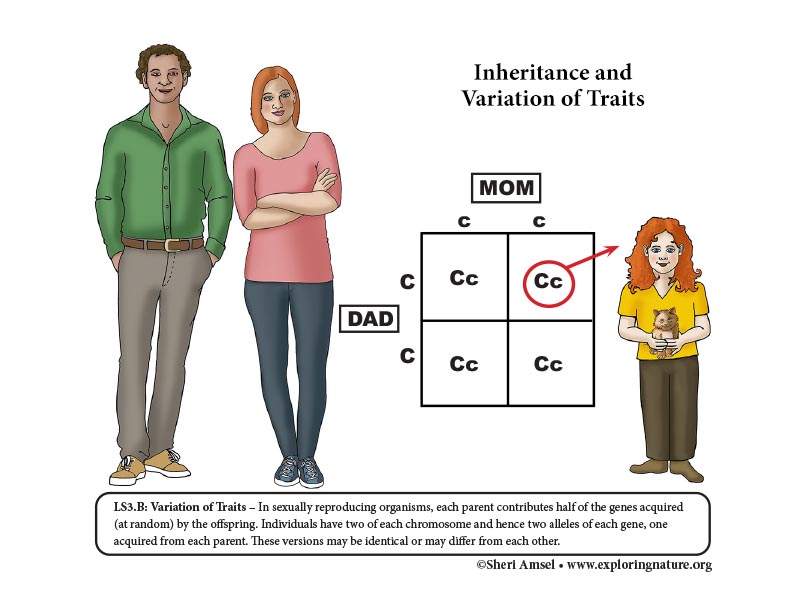

Organisms inherit characteristics or traits from their parents. For example, you may inherit your eye and hair color, height, skin tone, and body shape from one or the other of your parents. You don’t have all the exact traits of your parents, because the traits you inherit are a combination of genes (that code for traits) from each parent. You inherit half your DNA and genes from each parent.
Some traits result from interacting with the environment. We are affected by the foods we eat, the amount of sunlight or chemicals we are exposed to, and even how much exercise we get. The environment can shape those traits and affect the development, appearance, behavior, and even survival of an organism over time. So, inheritance of traits and interacting with the environment are what creates variation of traits in organisms and variations of traits in populations of organisms.
The genes we inherit are found on the 23 pairs of chromosomes in the nucleus of each of our cells. One set of chromosomes comes from each parent. Males provide the sperm and females provide the egg - each containing half the genetic information of all their offspring. This is called sexual reproduction. If one set of parents has many offspring, they may all look very different from each other because of this variation of traits. Though rare, variations of traits can also result from genetic mutations. This is because as your DNA is duplicating, occasionally it can make mistakes which can result in changes - mutations.
Because we get two sets of 23 chromosomes (one set from each parent), it means that we actually have two sets of genetic instructions - two genes for each trait. These matched genes are found in the same location on each of the paired chromosomes (homologous chromosomes) and are called alleles. These alleles may code for the same trait or different forms of the same trait. For example, there are two alleles that decide whether offspring will have curly hair or straight hair. One allele codes for curly hair and one codes for straight hair. When the two alleles for a trait are alike, they are said to be homozygous. When they are different, they are heterozygous. When one allele suppresses the expression of the other, it is said to be dominant and the suppressed allele is recessive. Dominant alleles (and the traits they represent) are illustrated with capital letters and recessive alleles with lower case letters. (In this case curly hair would be H and straight hair would be h.).
The dominant allele (trait) is visible or expressed, when it is alone, even though the other allele represents the opposite trait – this is heterozygous. When both alleles are the dominant, it is homozygous and the trait is also expressed. The recessive alleles, however, have to both be present (homozygous) for their trait to be visible (expressed). For example, a person with curly hair could have a HH allele combination (homozygous) or a Hh combination (heterozygous) and still have the dominant trait expressed visually (curly hair), but a person with straight hair must have both recessive alleles - hh - for the trait to be visible (expressed).
Your genetic code for various gene pairs, whether your traits are homozygous or heterozygous, is called your genotype. The way your genotype is expressed - which traits are visible, is called your phenotype. This genetic code can be expressed visually through a Punnett Square.
In this example below, both parents are homozygous – Dad with the dominant curly hair genotype and Mom with the recessive straight hair genotype. Their daughter, and, in fact, any offspring thay have, will be heterozygous genotype and express the dominant curly hair phenotype.
Test what you learned from this reading with a Inheritance and Variation of Traits vocabulary quiz.
When you research information you must cite the reference. Citing for websites is different from citing from books, magazines and periodicals. The style of citing shown here is from the MLA Style Citations (Modern Language Association).
When citing a WEBSITE the general format is as follows.
Author Last Name, First Name(s). "Title: Subtitle of Part of Web Page, if appropriate." Title: Subtitle: Section of Page if appropriate. Sponsoring/Publishing Agency, If Given. Additional significant descriptive information. Date of Electronic Publication or other Date, such as Last Updated. Day Month Year of access < URL >.
Amsel, Sheri. "Inheritance and Variation of Traits Reading (6-8 Grade)" Exploring Nature Educational Resource ©2005-2024. December 13, 2024
< http://www.exploringnature.org/db/view/Inheritance-and-Variation-of-Traits-Reading-6-8-Grade >
